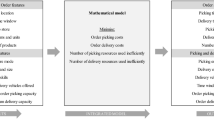Abstract
This study investigates the impacts of an electronic marketplace with multiple independent retailers for a smart grocery ordering system. Apart from replenishing products from suppliers, the system can also purchase/sell products from/to the electronic marketplace through ‘spot shops’. Both static and dynamic pricing models for the electronic marketplace are developed. An extensive numerical experiment is conducted and the results show that under both static and dynamic pricing, (i) the inventory cost of the aggregated supply chain is significantly reduced; (ii) each participant also enjoys significant cost savings from employing the electronic marketplace. Furthermore, the cost savings increase as the lead times from suppliers increase and/or the variability of their demands increases. The participants’ cost savings also increase as more participants employ the electronic marketplace.
Similar content being viewed by others
References
Barankin E. W. (1961) A delivery-lag inventory model with an emergency provision. Naval Research Logistics Quarterly 8: 285–311
Chiang C. (2001) A note on optimal policies for a periodic inventory system with emergency orders. Computers and Operations Research 28: 93–103
Chiang C. (2003) Optimal replenishment for a periodic review inventory system with two supply modes. European Journal of Operational Research 149: 229–244
Chiang C., Gutierrez G. J. (1996) A periodic review inventory system with two supply modes. European Journal of Operational Research 94: 527–547
Chiang C., Gutierrez G. J. (1998) Optimal control policies for a periodic review inventory system with emergency orders. Naval Research Logistics 45: 187–204
Daniel K. H. (1962) A delivery-lag inventory model with emergency. In: Scarf H. E., Gilford D. M., Shelly M. W. (eds) Multistage inventory models and techniques. Stanford University Press, Stanford, CA
Dong, L., & Durbin, E. (2001). Markets for surplus components with a strategic supplier. Working paper, Olin School of Business, Washington University, St. Louis, MO. Available online at: http://www.olin.wustl.edu/workingpapers/pdf/2003-10-003.pdf.
Fukuda Y. (1964) Optimal policies for the inventory problem with negotiable leadtime. Management Science 10(4): 690–708
Geoffrion A. M., Krishnan R. (2003) E-business and management science: Mutual impacts (Part 1 of 2). Management Science 49(10): 1275–1286
Geoffrion A. M., Krishnan R. (2003) E-business and management science: Mutual impacts (Part 2 of 2). Management Science 49(11): 1445–1456
Grieger M. (2003) Electronic marketplaces: A literature review and a call for supply chain management research. European Journal of Operational Research 144: 280–294
Hong K., Kim H. J., Lee C. (2007) Automated grocery ordering systems for smart home. Future Generation Communication and Networking 2: 87–92
Johnson, C., Delhagen, K., & Dash, A. (2002). US e-commerce: The next five years. Forrester Report, August 27, 2002.
Kaplan, S., & Sawhney, M. (2000). E-hubs: The new B2B marketplaces. Harvard Business Review (May/June), 97–104.
Keskinocak P., Tayur S. (2001) Quantitative analysis for internet-enabled supply chains. Interfaces 31(2): 70–89
Lee L. H., Lee C., Bao J. (2006) Inventory control in the presence of an electronic marketplace. European Journal of Operational Research 174: 797–815
Lee H. L., Whang S. (2002) The impact of the secondary market on the supply chain. Management Science 48(6): 719–731
Neuts M. F. (1964) An inventory model with optional lag time. Journal of SIAM 12(1): 179–185
Peleg B., Lee H. L., Hausman W. H. (2002) Short-term e-procurement strategies versus long-term contract. Production and Operations Management 11(4): 458–479
Simchi-Levi D., Wu D., Shen Z. (2004) Handbook of quantitative supply chain analysis: Modeling in the e-business era. Kluwer, Dordrecht
Tagaras G., Vlachos D. (2001) A periodic review inventory system with emergency replenishment. Management Science 47(3): 415–429
Veinott A. F. Jr. (1966) The status of mathematical inventory theory. Management Science 12(11): 745–777
Author information
Authors and Affiliations
Corresponding author
Rights and permissions
About this article
Cite this article
Lee, L.H., Lee, C. & Bao, J. The Impacts of an Electronic Marketplace with Multiple Independent Retailers for Smart Grocery Ordering Systems. Wireless Pers Commun 60, 475–487 (2011). https://doi.org/10.1007/s11277-011-0303-x
Published:
Issue Date:
DOI: https://doi.org/10.1007/s11277-011-0303-x




